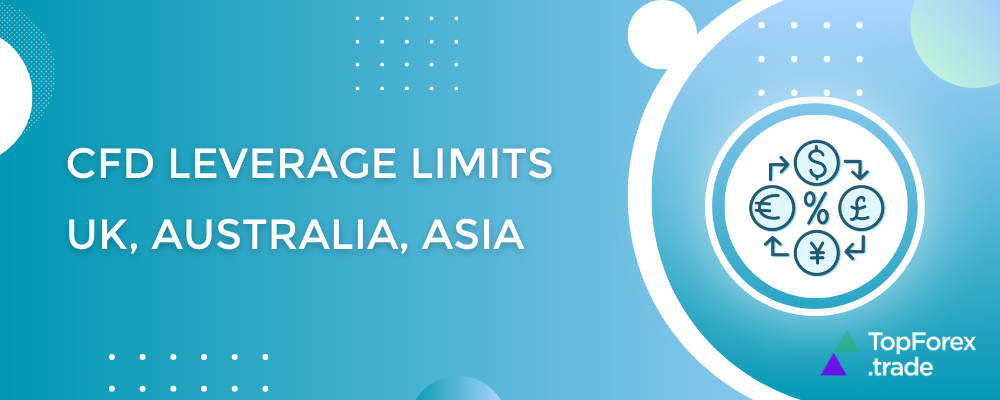How CFD leverage limits differ between the UK, Australia, and Asia

Contracts for Difference (CFDs) are popular trading instruments that allow traders to speculate on price movements without owning the underlying asset. One of the key attractions of CFD trading is leverage, which enables traders to control larger positions with a relatively small amount of capital. However, leverage limits vary significantly across different regions due to regulatory restrictions.
This article explores the differences in CFD leverage limits between the UK, Australia, and Asia, and highlights five top brokers offering competitive leverage.
CFD leverage limits in the UK

The UK is regulated by the Financial Conduct Authority (FCA), which has imposed strict leverage limits to protect retail traders. These restrictions were introduced under ESMA (European Securities and Markets Authority) guidelines and include:
- Major forex pairs: 1:30
- Minor forex pairs, gold, major indices: 1:20
- Commodities (excluding gold) and minor indices: 1:10
- Cryptocurrencies: 1:2
- Stocks and ETFs: 1:5
Professional clients exception: Traders classified as “professional clients” (based on experience, trading volume, and net worth) can access higher leverage (e.g., 1:200+), but most retail traders are restricted to the above limits.
Impact on traders:
- Lower risk of margin calls
- Reduced profit potential
- More sustainable trading for beginners
CFD leverage limits in Australia

Australia’s regulatory body, the Australian Securities and Investments Commission (ASIC), has historically allowed higher leverage than the UK. However, recent changes have tightened restrictions:
- Major forex pairs: 1:30 (reduced from 1:500 previously)
- Minor forex pairs and gold: 1:20
- Commodities and indices: 1:20
- Cryptocurrencies: 1:5
- Stocks: 1:5
While still more flexible than the UK, ASIC has moved closer to European standards to enhance trader protection.
Professional traders in Australia: Like the UK, eligible professional traders can access higher leverage (e.g., 1:200 – 1:500) by meeting ASIC’s criteria.
Impact on traders:
- More balanced risk than offshore brokers
- Still higher leverage than the UK for some assets
- Fewer sudden liquidations compared to 1:500+ leverage
CFD leverage limits in Asia

Asia has a more diverse regulatory landscape, with some jurisdictions offering much higher leverage. Countries like Singapore (MAS-regulated), Japan (FSA-regulated), and offshore brokers in Cyprus (CySEC) or the Seychelles (FSA) have varying rules:
a) Strict regulators (similar to FCA/ASIC):
- Japan (FSA): Max 1:10 for forex
- Singapore (MAS): Max 1:20 – 1:30
- Hong Kong (SFC): Max 1:20
b) Offshore brokers (high leverage):
Many traders in Asia use offshore brokers (regulated in Cyprus, Seychelles, or Vanuatu) for higher leverage:
- Major forex pairs: 1:500 – 1:1000+
- Indices and commodities: 1:200 – 1:500
- Cryptocurrencies: 1:50 – 1:100
Top 5 Forex brokers with flexible leverage
For traders seeking flexible leverage, here are five top brokers:
Exness
- Max leverage: 1:unlimited (for pros)
- Regulation: CySEC, FSA (Seychelles)
- Best for: Ultra-high leverage traders
XM Group
- Max leverage: 1:1000 (on certain accounts)
- Regulation: ASIC, CySEC, IFSC
- Best for: Flexible account types
HF Markets (HFM)
- Max leverage: 1:1000 (Pro accounts)
- Regulation: CySEC, FSCA, FSA
- Best for: MetaTrader users
AvaTrade
- Max leverage: 1:400 (pro clients)
- Regulation: ASIC, FSCA, CySEC
- Best for: Diverse asset selection
BlackBull Markets
- Max leverage: 1:500
- Regulation: FMA (NZ), FSA (Seychelles)
- Best for: ECN trading & tight spreads
Final thoughts: which leverage is best for you?
- UK/FCA brokers: Safest, but lowest leverage (1:30 max).
- Australia/ASIC brokers: Moderate (1:30 – 1:500 for pros).
- Asia/Offshore brokers: Highest leverage (1:1000+), but higher risk.
Choose based on your risk tolerance:
🔹 Beginners: Stick to FCA/ASIC brokers (1:30).
🔹 Experienced traders: Consider offshore brokers (1:500+).
Related articles:
CFD leverage UK, Australia, and Asia - FAQ